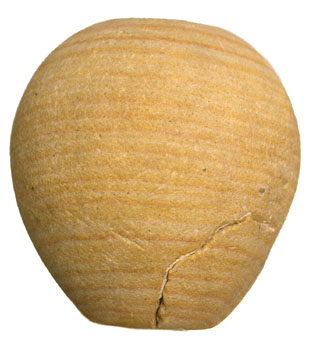Institute of Egyptian Art & Archaeology
Predynastic Maceheads


|
1981.1.2 (not on display) Date: Predynastic Period, Naqada II (c. 3600-3100 B.C.E.) Material: Pink banded limestone Provenance: Tomb 4 at Mesaeed, Egypt |
1991.2.1 Date: Predynastic Period, Naqada II (c. 3600-3100 B.C.E.) Material: Hematite Provenance: Egypt attributed |
A maces is a club-like weapon with a heavy head on a handle. These weapons are characteristic
of the Gerzean or Naqada II culture of the Predynastic Period. Two forms of maceheads
were common in the Predynastic Period which were the pear-shaped or "piriform" maceheads
andthe disk-shaped maceheads. The piriform maceheads replaced the earlier disk-shaped
maceheads. They were made in a variety of stones, though limestone was the preferred
medium in the Late Predynastic. Maceheads were placed on handles usually made of organic
material such as wood or ivory and are thus rarely preserved.
The pear-shaped macehead was used both as a weapon and as a ceremonial object. The ceremonial maceheads were often much larger than functional ones and sometimes were decorated. Maces were also found in both male and female Predynastic graves. Dynastic scenes show the pharaoh smiting the enemies of Egypt with a pear-shaped mace, long after the actual weapon became obsolete. An early example shows King Narmer on the front of the Narmer Palette using this form of mace.
The limestone macehead was excavated by the Harvard University and Museum of Fine Arts Boston joint expedition in 1910. Mesaeed is a predynastic cemetery site across the Nile from Abydos. A variety of flint knives, a flint scrapper, pottery, and other artifacts were also found in this excavation and are located at the Museum of Fine Arts, in Boston.
Inv. no. 1981.1.2
